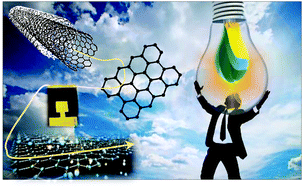当前位置:
X-MOL 学术
›
Energy Environ. Sci.
›
论文详情
Our official English website, www.x-mol.net, welcomes your
feedback! (Note: you will need to create a separate account there.)
Carbon-based materials for stable, cheaper and large-scale processable perovskite solar cells
Energy & Environmental Science ( IF 32.4 ) Pub Date : 2019-10-25 , DOI: 10.1039/c9ee02115a Lucia Fagiolari 1, 2, 3, 4, 5 , Federico Bella 1, 2, 3, 4, 5
Energy & Environmental Science ( IF 32.4 ) Pub Date : 2019-10-25 , DOI: 10.1039/c9ee02115a Lucia Fagiolari 1, 2, 3, 4, 5 , Federico Bella 1, 2, 3, 4, 5
Affiliation

|
Almost ten years after their first use in the photovoltaic (PV) field, perovskite solar cells (PSCs) are now hybrid devices that, in addition to having reached silicon performance, can accelerate the energy transition and boost the use of abundant elements for their manufacturing process. However, noble metals (in particular gold) represent the most typically used sources for back electrode fabrication, and this issue has been intensively considered by the research community in the last five years. This review shows how the most promising solution, considering also the need to develop a large-scale production process, is based on the use of carbon-based materials for the preparation of back electrodes. Graphite, carbon black, graphene and carbon nanotubes (CNTs) have been proposed, functionalized and characterized, leading to laboratory-scale solar cells and modules capable of providing excellent efficiencies and ensuring stability greater than those of gold-based devices. Strengthened by these results and its hydrophobizing properties, carbon has also started to be used as an electron transporting material (ETM), with excellent results on both rigid and flexible substrates. This review discusses the major advances and the updated state-of-the-art in the carbon-based PSC scenario, keeping a solid trajectory where the accessibility, low cost, high electrical conductivity, chemical stability and controllable porosity of carbon are highlighted and exploited in the design of upscalable hybrid solar cells.
中文翻译:

碳基材料,用于稳定,便宜且可大规模加工的钙钛矿太阳能电池
钙钛矿太阳能电池(PSC)首次用于光伏(PV)领域已近十年,如今已成为混合设备,除了达到硅的性能外,还可以加速能量转换并促进大量元素在其制造中的使用。过程。然而,贵金属(特别是金)是制造背电极的最常用来源,并且在最近五年中研究界已对此问题进行了深入研究。这篇综述显示了最有前途的解决方案是如何考虑到开发大规模生产工艺的需要,是基于使用碳基材料制备背电极的。提出了石墨,炭黑,石墨烯和碳纳米管(CNT),并对其进行了功能化和表征,导致实验室规模的太阳能电池和模块能够提供比金基设备更高的效率并确保更高的稳定性。由于这些结果及其疏水性的增强,碳也已开始用作电子传输材料(ETM),在刚性和柔性基材上均具有优异的效果。这篇评论讨论了碳基PSC情景中的主要进展和最新技术,并保持了稳固的轨迹,突出并利用了碳的可及性,低成本,高电导率,化学稳定性和可控制的孔隙率设计可升级的混合太阳能电池。由于这些结果及其疏水性的增强,碳也已开始用作电子传输材料(ETM),在刚性和柔性基材上均具有优异的效果。这篇评论讨论了碳基PSC情景中的主要进展和最新技术,并保持了稳固的轨迹,突出并利用了碳的可及性,低成本,高电导率,化学稳定性和可控制的孔隙率设计可升级的混合太阳能电池。由于这些结果及其疏水性的增强,碳也已开始用作电子传输材料(ETM),在刚性和柔性基材上均具有优异的效果。这篇评论讨论了碳基PSC情景中的主要进展和最新技术,并保持了稳固的轨迹,突出并利用了碳的可及性,低成本,高电导率,化学稳定性和可控制的孔隙率设计可升级的混合太阳能电池。
更新日期:2019-12-04
中文翻译:

碳基材料,用于稳定,便宜且可大规模加工的钙钛矿太阳能电池
钙钛矿太阳能电池(PSC)首次用于光伏(PV)领域已近十年,如今已成为混合设备,除了达到硅的性能外,还可以加速能量转换并促进大量元素在其制造中的使用。过程。然而,贵金属(特别是金)是制造背电极的最常用来源,并且在最近五年中研究界已对此问题进行了深入研究。这篇综述显示了最有前途的解决方案是如何考虑到开发大规模生产工艺的需要,是基于使用碳基材料制备背电极的。提出了石墨,炭黑,石墨烯和碳纳米管(CNT),并对其进行了功能化和表征,导致实验室规模的太阳能电池和模块能够提供比金基设备更高的效率并确保更高的稳定性。由于这些结果及其疏水性的增强,碳也已开始用作电子传输材料(ETM),在刚性和柔性基材上均具有优异的效果。这篇评论讨论了碳基PSC情景中的主要进展和最新技术,并保持了稳固的轨迹,突出并利用了碳的可及性,低成本,高电导率,化学稳定性和可控制的孔隙率设计可升级的混合太阳能电池。由于这些结果及其疏水性的增强,碳也已开始用作电子传输材料(ETM),在刚性和柔性基材上均具有优异的效果。这篇评论讨论了碳基PSC情景中的主要进展和最新技术,并保持了稳固的轨迹,突出并利用了碳的可及性,低成本,高电导率,化学稳定性和可控制的孔隙率设计可升级的混合太阳能电池。由于这些结果及其疏水性的增强,碳也已开始用作电子传输材料(ETM),在刚性和柔性基材上均具有优异的效果。这篇评论讨论了碳基PSC情景中的主要进展和最新技术,并保持了稳固的轨迹,突出并利用了碳的可及性,低成本,高电导率,化学稳定性和可控制的孔隙率设计可升级的混合太阳能电池。











































 京公网安备 11010802027423号
京公网安备 11010802027423号